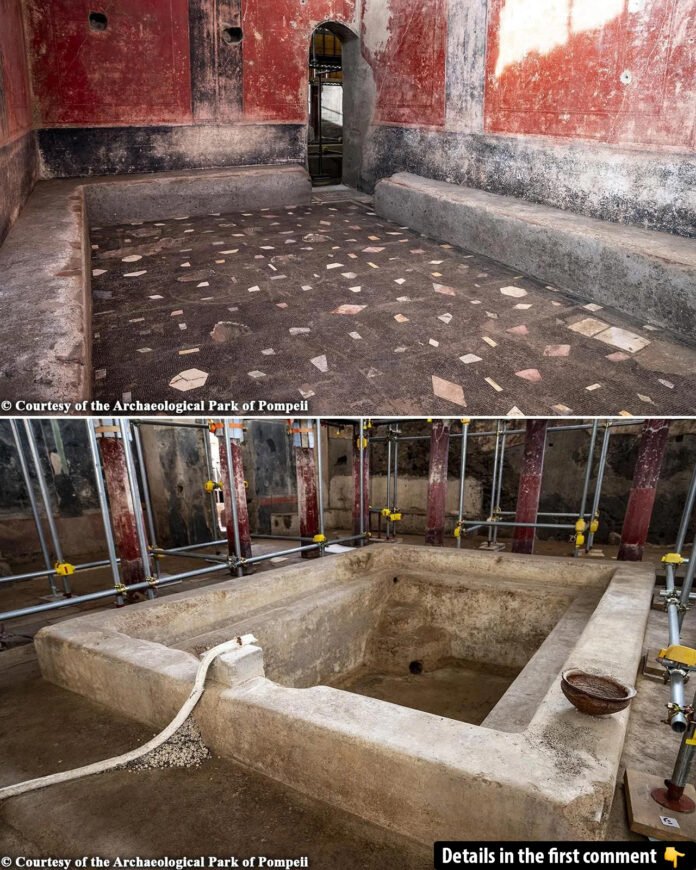The ruins of Pompeii continue to astound the world with their ability to reveal the intricacies of Roman life frozen in time. Recent archaeological excavations in Regio IX of the ancient city have unearthed an extraordinary private thermal spa complex. This discovery not only highlights the luxurious lifestyles of Pompeii’s elite but also underscores the city’s cultural sophistication and advanced engineering. The spa, part of a private residence, exemplifies the opulence of Roman domestic life, offering a rare glimpse into the intersection of leisure, politics, and engineering in the ancient world.
A Wealthy Neighborhood in Pompeii’s Regio IX
The spa complex is part of a lavish domus (house) located in Regio IX, one of Pompeii’s wealthiest districts. This area has yielded an array of fascinating finds, including bakeries, elaborately frescoed rooms, and evidence of home renovations. The house itself is thought to have belonged to Aulus Rustius Verus, a prominent local politician whose social status is reflected in the scale and grandeur of his home.
This particular domus was no ordinary residence. It featured spaces designed not just for living but also for hosting elaborate social gatherings. The discovery of a banquet hall directly connected to the thermal spa highlights the owner’s intent to use his home as a setting for political and social influence. By offering his guests a luxurious spa experience before grand feasts, the owner could impress his peers, secure political alliances, and reinforce his standing in society.
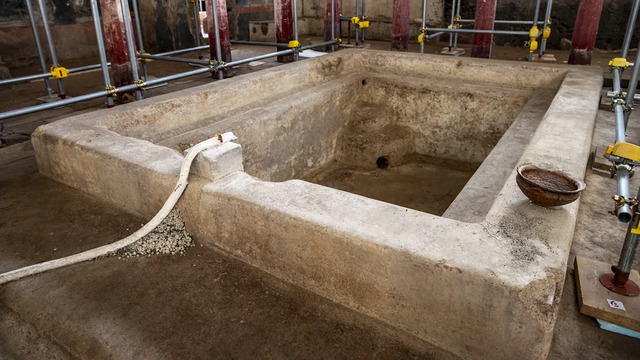
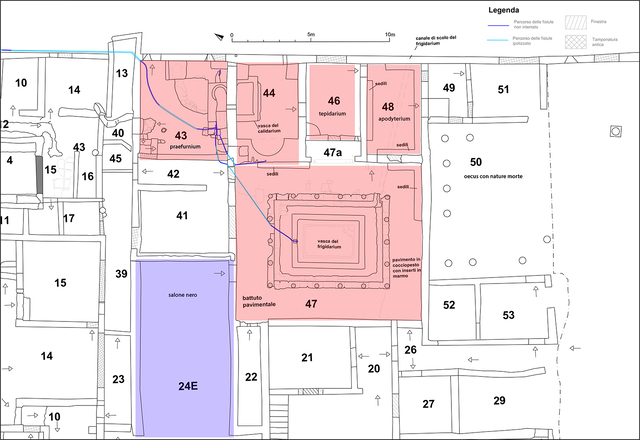
Video
Archaeologists have made a ‘once-in-a-century’ discovery at Pompeii – watch the BBC News video to uncover this extraordinary find and its historical importance!
The Architectural Grandeur of the Bath Complex
The bath complex discovered in this domus is one of the largest and most intricate private thermal spas unearthed in Pompeii. It features four distinct areas: the calidarium (hot room), tepidarium (warm room), frigidarium (cold room), and apodyterium (changing room). These spaces were designed not just for hygiene but for indulgence, relaxation, and social interaction.
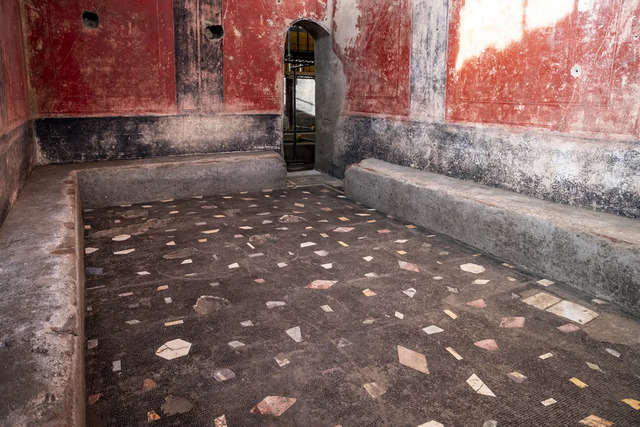
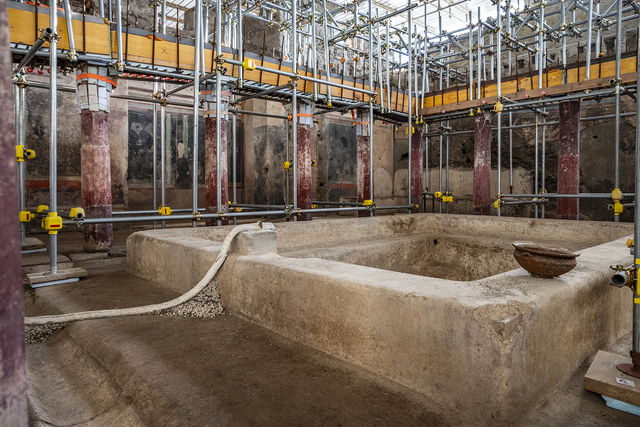
The architectural design is a testament to the opulence of Roman society. The walls of the spa are painted in vibrant black and red, with intricate frescoes depicting athletes engaged in sports. These images evoke the atmosphere of a Greek gymnasium, blending athleticism with cultural refinement. The floor is inlaid with marbles sourced from across the Roman Empire, further emphasizing the wealth and status of the homeowner.
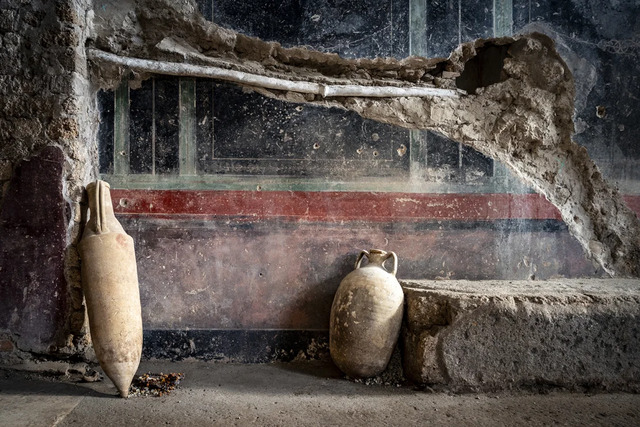
At the heart of the frigidarium lies a stunning peristyle—a courtyard surrounded by a portico supported by red-painted columns. Measuring 32 feet by 32 feet, this space features a large rectangular pool that could accommodate up to 30 guests. The careful design of this room reflects its dual purpose as both a functional bathing area and a venue for social gatherings.
Recreating the Roman Spa Experience
The connection between the thermal spa and the banquet hall suggests that this domus was designed to provide guests with a complete sensory experience. Visitors would begin their journey in the apodyterium, where built-in benches allowed them to change comfortably. They would then proceed to the calidarium, a sauna-like room heated by an advanced hypocaust system that channeled hot air under the floors and through the walls.
Next, they would move to the tepidarium, where they could enjoy massages and oil treatments. Oils were applied to the skin and then scraped off with metal strigils, leaving the skin clean and refreshed. The experience concluded in the frigidarium, where guests could take a dip in the cold pool to close their pores and cool down.
This sequence of activities mirrors the rituals described in Roman literature, such as the feasts in Gaius Petronius Arbiter’s “Satyricon.” These rituals were not merely about relaxation but also about showcasing the host’s hospitality, wealth, and cultural sophistication.
Advanced Engineering Behind the Bath Complex
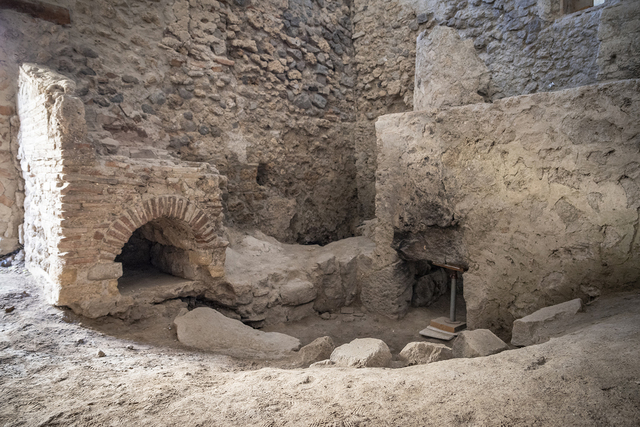
The thermal spa is a marvel of Roman engineering. The hypocaust heating system, which created the hot environment of the calidarium, demonstrates the ingenuity of ancient Roman technology. Hot air was generated in a furnace and circulated through a network of pipes under the floors and within the walls, maintaining consistent temperatures.
The boiler room, located adjacent to the calidarium, contained a lead boiler connected to a series of pipes that distributed hot and cold water throughout the spa. One pipe brought water in from the street, while another diverted water to the frigidarium pool. The valves controlling the flow of water were so well-preserved that they resemble modern utility systems, a testament to the durability and sophistication of Roman engineering.
Archaeological Challenges and Solutions
Excavating the bath complex posed significant challenges due to the structural instability of the peristyle colonnade, which had been buried under volcanic ash for nearly 2,000 years. To preserve the integrity of the columns and beams, archaeologists erected a temporary support structure that allowed them to excavate the area without dismantling the original architecture.
This innovative approach ensured that the bath complex could be studied in its original context, providing valuable insights into its design and function. The temporary support structure will remain in place until the peristyle is fully restored, allowing future generations to appreciate the architectural brilliance of this site.
Broader Implications of the Discovery
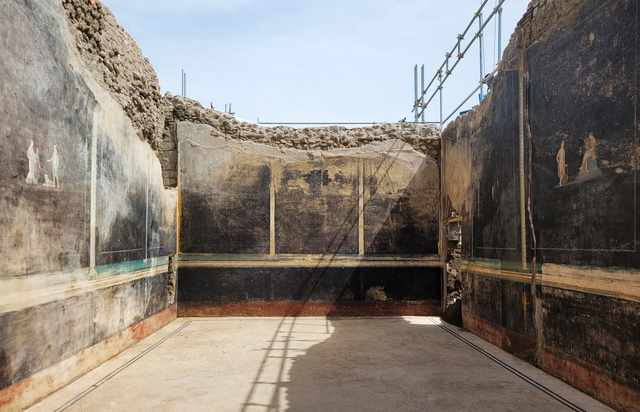
The discovery of this thermal spa offers more than just a glimpse into the luxurious lifestyles of Pompeii’s elite. It provides a window into the social dynamics of ancient Rome, where homes were not just private spaces but also venues for political and social networking. The combination of a thermal spa and banquet hall underscores the importance of hospitality in Roman culture and the lengths to which individuals would go to secure their social and political standing.
This find also highlights the advanced engineering and architectural techniques of the Roman Empire, challenging modern perceptions of ancient technology. From the hypocaust heating system to the marble-inlaid floors, the bath complex exemplifies the ingenuity and craftsmanship that defined Roman civilization.
Conclusion
The lavish thermal spa discovered in Regio IX of Pompeii is a remarkable testament to the opulence, sophistication, and engineering prowess of ancient Roman society. As archaeologists continue to uncover the secrets of this domus, they provide us with a deeper understanding of the cultural and social dynamics that shaped life in Pompeii. This discovery not only enriches our knowledge of Roman history but also serves as a poignant reminder of the fleeting nature of human achievements, preserved for eternity under the ash of Mount Vesuvius.
